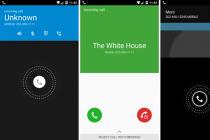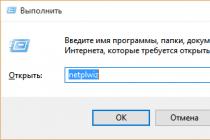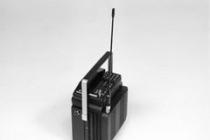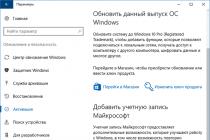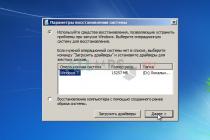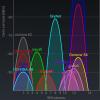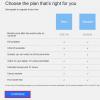How long can modern smartphones keep their relevance? Usually, it depends on the manufacturer who continues to support the smartphone by releasing new firmware and supporting it to the last.
Very much the relevance depends on the component base of the phone. Flagship devices are getting the very best components, which are often ahead of their time when budget smartphones are content with outdated technology.
As long as possible, you can use flagship devices of well-known manufacturers (A-brands), which have the latest spare parts and receive software updates for several years. I would like to tell you about one such device.
Specifications Sony Xperia ZL C6503 / C6502:
- Display - TFT matrix, 5 inches, resolution 1980 × 1080 pixels, density 441 ppi, screen-to-front ratio 76%
- Chipset - Qualcomm APQ8064 (S4 Pro) 4 cores, frequency 1.5 GHz. Video accelerator Adreno 320, frequency 533 MHz
- Memory - 2 GB RAM, 16 GB ROM, microSD card slot up to 32 GB
- Main camera - 13 MP, Exmor R
- Front camera - 2.1 MP
- Battery - 2370 mAh, STAMINA support
- Dimensions - 131.6 x 69.3 x 9.8 mm and weighs 151 grams
- Interfaces - micro-USB, Wi-Fi, Bluetooth, GPS, NFC
- OS - Android 4.1 with update to Android 5.1 and proprietary shell Xperia Home
- Colors - white, black and red
3 years of experience with Sony Xperia ZL
It so happened that more than three years ago I became the proud owner of a Sony Xperia ZL smartphone, which I continue to use to this day. By the way, I consider it one of the most successful Xperia devices in recent years.
This model was announced in January 2013 at the CES 2013 electronics exhibition along with the first smartphone under the letter Z.
Then, Sony decided to rethink its line with the introduction of the OmniBalance design concept, some ideas of which are still used today (for example, round button power supply in budget smartphones).
The flagship was the Sony Xperia Z, which had water resistance, powerful filling and an attractive design. Prior to that, a simple device in a massive body was considered a protected smartphone, but Sony showed that this may not be the case.
His younger brother was the Xperia ZL - the same "Zetka", but without moisture protection and in a different case. At the same time, ZL had at that time the maximum occupancy rate of the front panel screen - 76% screen / front panel ratio! This made it the smallest smartphone with a 5-inch screen.
3 years in the same hands
I'll start with why there was no desire to change it to newer ones. Sony models Xreria. The fact is that Sony has been supporting this smartphone with new firmware for a very long time. The initial release was Android 4.1 Jelly Bean. Later the phone received Android 4.2, 4.3, 4.4, 5.0 and the latest the official version became Android 5.1 Lollipop.
This allowed us to use the latest applications to this day. Also, with each firmware, the number of system bugs decreased, and the speed of work increased.
Wear resistance
The body of the smartphone turned out to be quite sturdy. He survived many falls on the floor (linoleum, tiles, asphalt), was exposed to moisture and dust, low and high temperatures. In my white version of the Xperia ZL, after 2 years, paint began to peel off on various elements. Otherwise, everything is very good: nothing loosens, does not stagger, the camera window and screen are not worn out, it is still not a shame to take it in your hand. I want to note that my friend, the black version of this smartphone does not have such problems with paint.
![]()
![]()
![]()
![]()
![]()
![]()
Camera
The Xperia ZL is equipped with two cameras: the front 2.1 Mp and the rear 13 Mp Exmor R. As for the front camera, its capabilities lasted for a long time. When the phone first came out, "selfies" were not yet so popular, so something better in 2013 was rare. Of course, now even budget devices have 5 megapixel modules, so in this regard the device looks outdated.
However, the quality is enough for video calls through any services. The location of the camera in the lower right corner of the smartphone was not very convenient, which did not allow talking while holding the phone vertically.
The rear camera of the Xperia ZL has proven its worth over the years. The quality is acceptable even now. In good weather, decent shots are obtained, the video also shoots well. However, due to the lack of performance, we had to abandon AR modes, as they work very slowly and heat up the phone a lot.
I bring to your attention a selection of some, in my opinion, successful shots made over the years:
![]()
![]()
![]()
![]()
![]()
![]()
![]()
Screen
Strong Xperia side ZL had a screen at the time of its market launch. The FHD matrix provides a pixel density of 441 ppi for maximum clarity even now. The screen is made using TFT TN technology, so the picture is inferior to any modern IPS and AMOLED matrices, has poor viewing angles, which is one of the main disadvantages of the device. I think the main advantage is high brightness and readability in direct sunlight.
Performance and battery life
Qualcomm APQ8064, 1500 MHz, also known as S4 Pro, Adreno 320 video accelerator and 2 GB is used as a platform random access memory... At the time of release, it was one of the most powerful platforms. The smartphone just flew on it, and any toys went without problems.
Now the performance of the device is not enough and only thanks to the optimized firmware the device can be used, although many applications, such as 2Gis, take a very long time to load.
What is there to be surprised, because even budget smartphone The 2016 Xperia XA on the Mediatek P10 platform is more powerful. The heating of the device is noticeable, which, with prolonged use of the phone, begins to literally burn your hands.
Time autonomous work was not the strongest point of the device. A 2370 mAh battery coupled with a gluttonous platform and a TFT screen is clearly not enough for long-term operation.
However, the STAMINA mode helped a lot, which saved precious percentages of the charge. I want to note that after three years of use, with about one charge per day, the device does not yet require battery replacement. The capacity, of course, fell, but the percentages do not "jump", although there is a noticeable decrease in battery life.
Software
The latest firmware version runs on Android 5.1 Lollipop, which can already be considered obsolete. In this case, you can bring the phone to modern look through various programs.
For example, I became a member Xperia programs Home Beta, which made it possible to get new version shell. App icons from the Xperia X range can be obtained by installing the corresponding themes from the store. Also, I really liked the new official Sony themes in the spirit of the PlayStation.
The speed of the system is decent, everything works pretty fast.
Communication and sound
There were no complaints about the quality of communication. The sound of the spoken speaker is loud, but it became so only on latest versions firmware. Before that, it was much quieter, which was pretty annoying. The vibration is strong, but very strange in sound, rattling. The sound in the headphones is worthy for its time.
Xperia ZL had two versions with a difference in 4G support, there is no dual-SIM version. I got the C6502 model, which differed from the base one by the lack of 4G. Long time this did not pose a problem as 4G coverage in 2013 was worse than it is now.
***
As a result, I can say that the Xperia ZL has faithfully served its intended period and continues to function properly.
What advantages can I put for this gadget after such a long period of use?
Pros:
Stylish design
A powerful platform for its time
Long software support for the device from Sony
Decent cameras
Excellent sun exposure and high resolution
Small size for 5 ″ screen
Minuses:
- Small viewing angles of the screen
- The phone case in the white version is prone to paint peeling
- Inconvenient location front camera
Xperia ZL - a worthy representative of the line Sony smartphones created in an era when the company was showing very interesting, competitive and coveted devices. Sony Mobile tried its best to support this device, which earns respect and desire to continue to use the products of the Japanese company.
Only a logical question arises: what can be replaced? For a long time, Sony produced beautiful, but inferior phones in terms of key parameters, which pretty much crippled the mobile business.
The Z1, Z2, Z3 and Z3 + (Z4) lines are no longer relevant, since they do not have a fingerprint scanner, the front cameras are weak, in some of the models there are problems with marriage and overheating, and so on.
The Xperia Z5 series costs almost like the Xperia X and XZ, and the shell is outdated, the scanner is not the most sensitive and the cameras are worse. The situation was slightly aggravated by the transition of the industry to USB-C connector, which seems to me more convenient and modern, which immediately rendered obsolete a lot of good smartphones with old micro-USB.
That changed in the spring of 2017 when the mind-blowing and balanced Xperia XZs was unveiled at MWC. Finally, smartphones have appeared that are more modern from all sides than the old ZL, and this difference is already felt very strongly.
New items do not have, at first glance, weaknesses and are filled with the spirit of Sony Style to the eyeballs. If the prices for them are competitive, then they are guaranteed good sales.
If you still use older Xperia devices, please share them in the comments. What do you want to change them to and why?

In order not to waste either your or my time, I will immediately say about the main thing: inside this device and Sony Xperia Z are twins. The same processors, the same set of applications, the same bundle - only the ZL does not have a docking station. Accordingly, in this material I will focus on the most important differences, and you can read about performance and a number of other parameters in Sony review Xperia Z.
In the comments, I heard a lot of opinions from different people, they say, not everything is so bad and you can live with the Z display. Like, the camera is better here than in the iPhone, you just need to shoot in normal conditions, and you can get used to the size, and everything else. An interesting practice, buying a smartphone, and then getting used to it - for me it is not entirely clear. But Sony did the right thing by creating two very different devices, initially I liked the Sony Xperia Z (despite the many "buts"), but in everyday use the ZL turned out to be much more convenient. Friends from Sony told me about this phenomenon back in Las Vegas - they say, size does matter. Let's in this material let's talk about a smartphone that is not a flagship. But it is he who can become the flagship for Sony in terms of sales.
Design, construction
Against the background of its Z-brother, the device does not look so impressive. Yes, the same concept is used here: an aluminum button on the side, interestingly designed ends, but there is no glass at the back. Upon closer examination, it turns out that ZL is in many ways more interesting than Z. Ribbed and velvety plastic on the battery cover, protruding Xperia lettering on the back, a beautiful indicator under the display, no plugs. To insert headphones into a plug or a microUSB cable, you do not need to pry all these hatches - it is convenient. There are controversial solutions here, the lid on the back opens access to the slots for the memory card and the SIM card, somewhat resembles a trunk. It is fastened with some kind of weak rubber band, so do not tear the cover too hard. When it snaps into place, it does not play and does not go from side to side, all rear part like a monolith, it is impossible to bend the battery cover. Both the Z and the ZL are remarkably assembled, but the ZL is also very good in the hand. The dimensions are 131.6 x 69.3 x 9.8 mm and weighs 151 grams, heavier than the iPhone 4S. A weighty bar, I personally enjoy this heaviness. Well, back to the size again, after walking around with Z for a week, the ZL seems very small, the thumb reaches any corner of the five-inch display. In addition to black, there is also a white version, I like both.

In order to place such a display in such a compact case, the engineers had to go to a number of tweaks. For example, the front camera had to be moved down, I already talked about the hatch in the back, but its appearance is connected just with attempts to make the body smaller. By the way, at the bottom left there is a traditional groove for attaching a strap, Sony cannot do without it.




I won't talk about the design of the ZL for a long time, it looks not quite traditional for Sony, from the back it generally resembles HTC, but all this is when you look at the pictures. In life, the device is original, with a number of special solutions. Let me remind you once again about the pleasant velvety plastic on the back, because of the notches, fingerprints are invisible here, but they remain on the film that protects the display. The camera is enclosed in a round bezel, below there is a flash, next to it is a speaker slot, strange, but all this is not perceived as a jumble of different elements. On the right side, above the aluminum button, there is a thin volume rocker, which is convenient. There is also a camera button below, which is nice, with its help you can quickly activate it and take a picture (or record a video).








The indicator light is well made, in the traditional style of Sony, a kind of strip - it can light up in different colors depending on what is happening with the device. And you immediately notice that there are practically no frames on the left and right, the device resembles an iPad mini.


The set includes the same headset as with the Sony Xperia Z, based on the EX-300. For Sony, it does not cost anything, and users will surely appreciate the care, listening to music is much more interesting with just such a headset, and even better, immediately install a third-party player.



The SIM card format is microSIM, so iPhone 5 users will need an adapter if they want to switch phones. Another (in fact, the main) difference from the Sony Xperia Z is the lack of protection from water, I do not recommend swimming with the ZL. But there are no plugs.



Display
It seemed to me that the display here is better than in the Sony Xperia Z, although in all the main parameters they seem to be the same. It is TFT, 5 inches diagonal, resolution 1920 x 1080 pixels, but here the viewing angles seem to be better, more saturated colors, although the black is the same. I don't know how Sony works as suppliers, but I really want to believe that the company will be able to defeat bad businessmen - after all, there is so much talk about Bravia and so on, and the displays of Samsung, HTC and Apple are a hundred times better. So, if we compare with Z, then the screen is slightly better, if we compare with competitors, then it does not stand up to criticism. When looking at close range, everything is fine, it is worth changing the angle - the image becomes faded.







The display is covered by glass, there is a factory film on the glass, I do not advise you to tear it off, the Sony inscription can also peel off. Widgets, wallpapers and more are the same as those of the Sony Xperia Z.



Nuances
The Sony Xperia ZL, unlike the Z, has an infrared port, there is a program remote control, apparently, there is a port somewhere near the power button. In the settings, you can select the type of device, brand name, and then the program appears. I tried the system with home appliances, I really liked it, Samsung TV was recognized instantly, you can turn it on and off, select programs, an image source, and so on - everything, just like with a conventional remote control. The operating range is the same as that of a conventional remote control. Among the types of devices, there are even docking stations for Apple technology, stereos - I tried with music center Pioneer, everything also works quite correctly. The program is done well, the added devices appear in the general menu with the names of your choice and quite understandable icons.





As for performance, memory and other things, everything is exactly the same as in the Sony Xperia ZL: the same set of programs, the same wallpapers, the operating speed is similar, although for a device with such a processor it is not clear how to load it. Unless installing various benchmarks and running them around the clock - I want to believe that the owners of Sony are not doing such nonsense. I want to remind you that all the official descriptions say that the device supports microSD memory cards up to 32 GB, this is not true - apparently, people from Sony did not have a 64 GB card. I tried it, everything works. Once again, I will give here a link to the Z review, for details you should go there.






The battery life is the same as that of the Z, when using Chrome the battery "melts" before our eyes, so it is better to choose another browser. If you use ZL only for conversations and SMS, turn on Stamina mode, then you can achieve two or even three days of work - just do not forget to turn down the brightness, turn off all automatic synchronization, positioning systems, and so on. A full charge from USB takes about three hours, so it's best to use the included power supply. In normal mode, the device survived until the evening, but I didn’t deny myself anything and didn’t turn on Stamina.



The speaker is louder here than on the Z, this applies to both normal and spoken. Talking is also more comfortable, the interlocutors did not complain about the quality of speech transmission, the volume margin seemed to me more than that of Z.
The camera here is the same as that of the Z, I can safely say that the iPhone 5 shoots better and does not depend on any conditions, settings, or weather. Of all the effects that the ZL has, I often used only the burst mode, oddly enough, the photos in general are of better quality than in normal mode. I will give here a few pictures and videos from ZL, you can evaluate it yourself.




























conclusions
The device has a very piercing vibration, I have not met such a sharp motor for a long time, it looks like a drill. It is especially annoying when it works when you press the keyboard, but you can disable this yourself in the settings. On the other hand, when the silent mode is on, you simply won't be able to get a call, ZL literally jumps out of your pocket.
Here would be a screen like Htc one, I liked it more than SGS4, some kind of soft and velvety, does not hit the eyes. Here a team of programmers could work, fix all sorts of small jambs, put a polish, make some things as simple and convenient as proprietary software for controlling home appliances. Here would be to bring to mind the camera. Engineers have to work with the speaker so that it is not so shrill. And use a different motor to match the vibration with the weight and design of the device. There would be a thick instruction here so that people know how to use an Android smartphone, there would be a sticker on the packaging about LTE. And in general, manufacturers build a hell of a lot of different things into smartphones, but they don't bother to convey to consumers the possible use cases - there are a lot of functions, many are not used simply because people do not know.
There are a lot of things that could be improved to get a candy at the exit. Although the ZL turned out to be in the main more interesting than the Z - yes, the latter has a better design, it does not sink in water. But for everyday use, the ZL is much more convenient, it fits perfectly in the hand and the ribbed plastic on the back is certainly more pleasant than the slippery glass under the film. If you want to choose one of these two smartphones, then do not be lazy, hold both, weigh - in the photo Z is more beautiful, in life ZL is preferable. Moreover, there are no plugs.
The smartphone costs about 27,500 rubles, with the release of SGS4 Sony will have to revise the pricing of its flagships - although this is unlikely to save Z and ZL from marketing pressure. Rest assured, Samsung will spend such an advertising budget on the “four” that at every corner and from every slot you will be advised to buy it. This is neither good nor bad, it’s just a given, whoever has a bigger budget, that’s true. Since the announcement of Z and ZL, I keep repeating that the devices themselves turned out to be quite good - moreover, for Sony the stars were very successful. It took three months to prepare the market, launch it, but now it is necessary to sell, sell, sell as soon as possible, until the terrible SGS4 came. We need to sell and work hard on the next models, we need to look for another gap - a few months of life, then months of silence.
It takes a genius to change this situation. A genius who can send bad suppliers with bad screens to one place, a genius who can disperse all smoke screens in the form of complicated settings, a genius who does not forgive even the slightest jambs in software. Let's hope that Sony will find such a thing and Z together with ZL will become the last step on the way to something truly outstanding, incomparable, unparalleled. It's time. We are all tired of waiting.
P.S. Try to type ZL in Russian, you get an interesting result.
Sergey Kuzmin ()
pros
great sound, great screen, high performance, no lags, fits well in the hand!Minuses
The battery is not removable, there is no way to replace it with a more powerful one. The charge with average use in STAMINA mode lasts 1.5 days - not enough. With full load on the phone - Internet, movies, games - 1 day. It takes a long time to charge.Impressions
there was a choice between XPERIA Z and XPERIA ZL. Since I am not an active person and the water resistance of the phone is not important to me, I settled on the ZL model. The quality of the assembly is excellent, there are no backlashes, no creaking, the dimensions of the phone pleased me. It is smaller than the Z and the screen covers almost the entire surface of the phone. Fits perfectly in the hands. The back cover is grooved, non-slip. does not collect prints. I just turned on the phone and immediately received a message about the update from lags (if anyone remembers XPERIA Z died of lags) Sony fixed this problem almost immediately. The screen is great! Everything is very readable in the sun. The quality of video playback and photo viewing is just super! There is a white banas. Ed that the stock video player does not read avi, but I swung the MX player and forgot about this problem. The sound is great - Sony. The stock Walkman has so many settings that there is no need to download something extra. Camera - no complaints at all. Auto mode is enough for the eyes. Giblets - at the level! Not much in terms of performance, but the XPERIA Z beats it. There are no lags.Is the review helpful?
pros
Price / (functional quality), Beauty (especially white) and quality of the case,Minuses
Speaker sound, slightly screenImpressions
Yuzayu 10 days the flight is normal. A very nice model (I confess, appearance influenced the choice not least of all) hid it in an expensive leather case and burst into tears ... THIS IS UNFAIR. Taking into account the fall in price (B \ in Ukraine it was), when the Z1 was released, the model became even more interesting in terms of price-quality ratio. For one-handed use, the dimensions are marginal but still comfortable. The brightness of the screen is quite enough (in the sun it is better than amoled), there is an extension with a color change when looking at an angle, but ... why should I look at it at an angle ONCE) and everything is still readable TWO) although it is not clear why they did not make it perfectly shorter, minus completely small minus. Stunningly pleasant to the touch plastic on the back (envy and cry Samsung Galaxy s4). Camera ... I don't shoot my wedding standards for him, perhaps you can find better, although again, not much shorter - at the level. Autonomy is not bad as for an android I have 2 days, and the life time primarily depends not on calls, but on the screen time and the loading of the processor (so I opened my eyes to everyone, after all, no one expected;))), and when proper setting of the bucket (turning off unnecessary functions, competent jamming of games, etc.), this indicator can be slightly raised. Comparing it with the Z coy that I was twirling in my hands before the final choice in favor of Zl, I will say that as for me it is more pleasant in my hand and a little smaller in size, there are no plugs and the sound is louder (while I don’t call under water), there is an IR port for ph- All this, taking into account the same hardware platform and lower price, influenced my choice. Now I will scold a little for a change, here the sound of the speaker is not very ... no, it is loud (again, not very much, but enough), but after the nokia n95, which I have faithfully and truly does not sound Sonya at all for many years. SCHOOL !!! the phone is not for a musical change, mind you !!!
Choose this phone for looks and price and you will be satisfied. If you want advanced functionality and performance, look at the Galaxy C4, HTTs alone, or Sonya, but Z1
Is the review helpful?
Information about the brand, model and alternative names of a specific device, if any.
Design
Information about the dimensions and weight of the device, presented in different units of measurement. Used materials, offered colors, certificates.
| Width Width information - refers to the horizontal side of the device in its standard orientation during use. | 69.3 mm (millimeters) 6.93 cm (centimeters) 0.23 ft (feet) 2.73 in (inches) |
| Height Height information - refers to the vertical side of the device in its standard orientation during use. | 131.6 mm (millimeters) 13.16 cm (centimeters) 0.43 ft (feet) 5.18 in (inches) |
| Thickness Information about the thickness of the device in different units measurements. | 9.8 mm (millimeters) 0.98 cm (centimeters) 0.03 ft (feet) 0.39 in (inches) |
| The weight Information about the weight of the device in different units of measurement. | 151 g (grams) 0.33 lbs (pounds) 5.33 oz (ounces) |
| Volume The approximate volume of the device, calculated based on the dimensions provided by the manufacturer. Refers to devices with a rectangular parallelepiped shape. | 89.37 cm³ (cubic centimeters) 5.43 in³ (cubic inches) |
| Colors Information about the colors in which this device is offered for sale. | Black White Red |
SIM card
The SIM card is used in mobile devices to store data that certifies the authenticity of mobile service subscribers.
Mobile networks
A mobile network is a radio system that allows multiple mobile devices to communicate with each other.
| GSM GSM (Global System for Mobile Communications) is designed to replace the analog mobile network (1G). For this reason, GSM is often referred to as a 2G mobile network. It is enhanced by the addition of GPRS (General Packet Radio Services) and later EDGE (Enhanced Data rates for GSM Evolution) technologies. | GSM 850 MHz GSM 900 MHz GSM 1800 MHz GSM 1900 MHz |
| UMTS UMTS stands for Universal Mobile Telecommunications System. It is based on the GSM standard and refers to 3G mobile networks. Developed by 3GPP and its biggest advantage is to provide more speed and spectral efficiency thanks to W-CDMA technology. | UMTS 850 MHz UMTS 900 MHz UMTS 1700/2100 MHz UMTS 1900 MHz UMTS 2100 MHz |
| LTE LTE (Long Term Evolution) is defined as a fourth generation (4G) technology. It is developed by 3GPP based on GSM / EDGE and UMTS / HSPA with the aim of increasing the capacity and speed of wireless mobile networks. The subsequent development of technologies is called LTE Advanced. | LTE 800 MHz LTE 850 MHz LTE 900 MHz LTE 1800 MHz LTE 1900 MHz LTE 2100 MHz LTE 2600 MHz |
Mobile technology and data rates
Communication between devices in mobile networks is carried out using technologies that provide different data transfer rates.
Operating system
An operating system is the system software that controls and coordinates the operation of hardware components in a device.
SoC (System on a Chip)
A system on a chip (SoC) integrates all the major hardware components of a mobile device into a single chip.
| SoC (System on a Chip) A system on a chip (SoC) integrates various hardware components such as a processor, graphics processor, memory, peripherals, interfaces, etc., as well as the software required for their operation. | Qualcomm Snapdragon S4 Pro APQ8064 |
| Technological process Information about the technological process by which the chip is manufactured. The value in nanometers is half the distance between the elements in the processor. | 28 nm (nanometers) |
| Processor (CPU) The main function of the processor (CPU) of a mobile device is to interpret and execute instructions contained in software applications. | Krait |
| Processor size The bit size of the processor is determined by the size (in bits) of registers, address buses and data buses. 64-bit processors offer better performance than 32-bit processors, which are more efficient than 16-bit processors. | 32 bit |
| Instruction set architecture Instructions are commands with which the software sets / controls the operation of the processor. Information about the instruction set (ISA) that the processor can execute. | ARMv7 |
| Level 0 cache (L0) Some processors have L0 (level 0) cache memory, which can be accessed faster than L1, L2, L3, etc. The advantage of having such memory is not only higher performance, but also lower power consumption. | 4KB + 4KB (kilobytes) |
| Level 1 cache (L1) The cache memory is used by the processor to reduce the time it takes to access more frequently used data and instructions. L1 (level 1) cache is small and is much faster than both system memory and other levels of cache. If the processor does not find the requested data in L1, it continues to look for it in the L2 cache. On some processors, this search is performed simultaneously in L1 and L2. | 16 KB + 16 KB (kilobytes) |
| L2 cache L2 (level 2) cache is slower than L1, but instead has a larger capacity to cache more data. It, like L1, is much faster than system memory (RAM). If the processor does not find the requested data in L2, it continues to look for them in L3 cache memory (if available) or in RAM memory. | 2048 KB (kilobytes) 2 MB (megabytes) |
| Number of processor cores The processor core executes program instructions. There are processors with one, two or more cores. Having more cores increases performance by allowing multiple instructions to execute in parallel. | 4 |
| CPU clock speed The clock speed of a processor describes its speed in cycles per second. It is measured in megahertz (MHz) or gigahertz (GHz). | 1500 MHz (megahertz) |
| Graphics processing unit (GPU) A graphics processing unit (GPU) handles computation for a variety of 2D / 3D graphics applications... V mobile devices it is used most often by games, consumer interface, video applications, and more. | Qualcomm Adreno 320 |
| Number of cores GPU Like a processor, a GPU is made up of several working parts called cores. They handle the graphical computation of various applications. | 4 |
| GPU clock speed Speed is the clock speed of the GPU and is measured in megahertz (MHz) or gigahertz (GHz). | 400 MHz (megahertz) |
| The amount of random access memory (RAM) Random access memory (RAM) is used by the operating system and all installed applications. The data that is saved in the RAM is lost after the device is turned off or restarted. | 2 GB (gigabytes) |
| Memory type (RAM) Information about the type of random access memory (RAM) used by the device. | LPDDR2 |
| Number of RAM channels Information about the number of RAM channels that are integrated into the SoC. More channels means more high speeds data transmission. | Two-channel |
| RAM frequency The frequency of the RAM determines its speed of operation, more specifically, the speed of reading / writing data. | 533 MHz (megahertz) |
| ROM-memory size ROM memory is read-only. In some mobile devices, this is inner memory which contains operating system... ROM data is retained even after the device is turned off. | 15258 MB (megabytes) 1.56242e + 7 KB (kilobytes) |
| Qualcomm Snapdragon S4 Pro APQ8064 + MDM9215M |
Built-in memory
Each mobile device has built-in (non-removable) fixed memory.
Memory cards
Memory cards are used in mobile devices to increase the storage space for data.
Screen
The screen of a mobile device is characterized by its technology, resolution, pixel density, diagonal length, color depth, etc.
| Type / technology One of the main characteristics of the screen is the technology by which it is made and on which the image quality of information directly depends. | TFT |
| Diagonal On mobile devices, screen size is expressed in terms of the length of its diagonal, measured in inches. | 5 in (inches) 127 mm (millimeters) 12.7 cm (centimeters) |
| Width Approximate screen width | 2.45 in (inches) 62.26 mm (millimeters) 6.23 cm (centimeters) |
| Height Approximate screen height | 4.36 in (inches) 110.69 mm (millimeters) 11.07 cm (centimeters) |
| Aspect ratio The aspect ratio of the long side of the screen to its short side | 1.778:1 16:9 |
| Permission Screen resolution indicates the number of pixels horizontally and vertically on the screen. Higher resolution means sharper image detail. | 1080 x 1920 pixels |
| Pixel density Information about the number of pixels per centimeter or inch of the screen. Higher density allows information to be shown on the screen in clearer detail. | 441 ppi (pixels per inch) 173 ppcm (pixels per centimeter) |
| Color depth Screen color depth reflects the total number of bits used for color components in one pixel. Information on maximum number colors that the screen can show. | 24 bit 16777216 flowers |
| Screen footprint The approximate percentage of the display area on the front of the device. | 75.81% (percent) |
| Other characteristics Information about other functions and features of the screen. | Capacitive Multitouch Scratch resistant |
| Shatter-proof sheet on scratch-resistant glass Sony Mobile BRAVIA Engine 2 Reality display |
Sensors
Different sensors perform different quantitative measurements and convert physical metrics into signals that can be recognized by the mobile device.
Rear camera
The main camera of a mobile device is usually located on its rear panel and can be combined with one or more additional cameras.
| Sensor model Information about the make and model of the sensor used by the camera. | Sony IMX135 Exmor RS |
| Sensor type Information about the type of camera sensor. Some of the most widely used types of sensors in mobile cameras are CMOS, BSI, ISOCELL, and others. | CMOS (complementary metal-oxide semiconductor) |
| Sensor size Information about the dimensions of the photosensor used in the device. Typically, cameras with a larger sensor and lower pixel density offer higher image quality despite lower resolution. | 4.69 x 3.52 mm (millimeters) 0.23 in (inches) |
| Pixel size Pixels are usually measured in microns. Larger pixels are capable of capturing more light and therefore provide better low-light performance and wider dynamic range than smaller pixels. On the other hand, smaller pixels allow for higher resolution while maintaining the same sensor size. | 1.136 μm (micrometers) 0.001136 mm (millimeters) |
| Crop factor The crop factor is the ratio between the size of a full-frame sensor (36 x 24 mm, equivalent to a frame of standard 35 mm film) and the size of the device's photo sensor. The number shown is the ratio of the diagonals of a full-frame sensor (43.3 mm) to that of a particular device's photo sensor. | 7.38 |
| Light-strength Aperture (also known as aperture, aperture, or f-number) is a measure of the size of the lens aperture, which determines the amount of light entering the sensor. The lower the f-number, the larger the aperture and the more light reaches the sensor. Typically, the f-number is indicated, which corresponds to the largest possible aperture of the aperture. | f / 2.4 |
| Flash type The rear (rear) cameras of mobile devices mainly use LED flashes. They can be configured with one, two or more light sources and vary in shape. | LED |
| Image Resolution Resolution is one of the main characteristics of cameras. It represents the number of horizontal and vertical pixels in the image. For convenience, smartphone manufacturers often quote resolutions in megapixels, indicating the approximate number of pixels in millions. | 4128 x 3096 pixels 12.78 MP (megapixels) |
| Video resolution Information about the maximum video resolution that the camera can record. | 1920 x 1080 pixels 2.07 MP (megapixels) |
| Video recording rate (frame rate) Information about the maximum recording rate (frames per second, fps) supported by the camera at maximum resolution. Some of the most basic video recording speeds are 24 fps, 25 fps, 30 fps, 60 fps. | 30 frames / sec (frames per second) |
| Specifications Information about additional software and hardware features of the rear (rear) camera. | Autofocus Burst shooting Digital image stabilization Geographic tags Panoramic shooting HDR shooting Touch focus Face recognition |
Front-camera
Smartphones have one or more front cameras of different designs - pop-up camera, PTZ camera, notch or hole in the display, camera under the display.
Audio
Information about the type of speakers and audio technology supported by the device.
Radio
The radio of the mobile device is a built-in FM receiver.
Locating
Information about the navigation and positioning technologies supported by the device.
Wi-Fi
Wi-Fi is a technology that enables wireless communication for transferring data over short distances between various devices.
Bluetooth
Bluetooth is a standard for secure wireless transfer of data between different types of devices over short distances.
| Version There are several versions of Bluetooth, each of which improves communication speed, coverage, and makes it easier to find and connect devices. Information about the Bluetooth version of the device. | 4.0 |
| Specifications Bluetooth uses different profiles and protocols to provide more fast exchange data, energy savings, better device discovery, and more. Some of these profiles and protocols that the device supports are shown here. | A2DP (Advanced Audio Distribution Profile) AVRCP (Audio / Visual Remote control Profile) GATT (Generic Attribute Profile) HDP (Health Device Profile) HFP (Hands-Free Profile) HID (Human Interface Profile) HSP (Headset Profile) MAP (Message Access Profile) OPP (Object Push Profile) PBAP / PAB (Phone Book Access Profile) |
USB
USB (Universal Serial Bus) is an industry standard that allows different electronic devices to exchange data.
HDMI
HDMI (High-Definition Multimedia Interface) is a digital audio / video interface that replaces older analog audio / video standards.
Headphone jack
This is an audio connector, which is also called an audio connector. The most widely used standard in mobile devices is the 3.5mm headphone jack.
Connecting devices
Information about other important connection technologies supported by the device.
Browser
A web browser is a software application for accessing and viewing information on the Internet.
Video file formats / codecs
Mobile devices support different video file formats and codecs, which respectively store and encode / decode digital video data.
Battery
Mobile device batteries differ in their capacity and technology. They provide the electrical charge required for their function.
| Capacity Battery capacity indicates the maximum charge it can store, measured in milliampere-hours. | 2370 mAh (milliampere-hours) |
| Type of The type of battery is determined by its structure and, more precisely, by the chemicals used. There are different types of batteries, with lithium-ion and lithium-ion polymer batteries most commonly used in mobile devices. | Li-Ion (Lithium-ion) |
| Talk time 2G Talk time in 2G is the period of time during which the battery charge is completely discharged during a continuous conversation on a 2G network. | 10 h (hours) 600 min (minutes) 0.4 days |
| Standby time 2G Standby time in 2G is the period of time during which the battery charge is completely discharged when the device is in stand-by mode and connected to a 2G network. | 500 h (hours) 30,000 minutes (minutes) 20.8 days |
| Talk time 3G Talk time in 3G is the period of time during which the battery charge is completely discharged during a continuous conversation on a 3G network. | 13 h (hours) 780 minutes (minutes) 0.5 days |
| 3G standby time Standby time in 3G is the period of time during which the battery charge is completely discharged when the device is in stand-by mode and connected to a 3G network. | 500 h (hours) 30,000 minutes (minutes) 20.8 days |
| Specifications Information about some additional characteristics of the device's battery. | Non-removable |
There was a time when big phones were called clunky and outdated. Time has replaced large devices with small, thin and fit in the smallest pocket. These small, ergonomic devices were sold like children to school. It got to the point that the phones "grew thin" to the size of Swiss knives. But then time played in the other direction. Buttons from telephones disappeared, the concept of "telephone" began to outlive its own, and the devices themselves began to grow by leaps and bounds. Just 3 years ago, I had buttons on my smartphone, and the display did not know prints and was only 2 inches in diagonal.
Everyone, drove through nostalgia. Now smartphones can easily "do" what we used to call a computer, and at the same time will be many times more convenient for many simple tasks such as Twitter and Skype conversations. So, at the beginning of the year at CES 2013, new flagships from Sony were presented. The Xperia Z is slightly more expensive than the ZL and is not afraid of water. At the same time, the ZL has a number of its own differences. I propose to look at one of the most large smartphones Sony - Xperia ZL.
First impressions
The smartphone comes in a medium-sized box. On a black and white cardboard - pictures of the device itself and logos of all sorts of bells and whistles. Inside - the smartphone itself, a charger with a detachable cable, pieces of paper and a vacuum headset with replaceable rubber tips for different auricles. Everything is packed in two layers, and fans of unpacking can enjoy the process of turning a new device into a used one for a couple of minutes. As usual, there are many manuals in two languages (Russian / Ukrainian).
The first activation is quick and smooth, with the exception of one moment: for some reason, the device at close range could not understand where it is and what time it needs to be automatically set. After changing the time zone, things did not change much, and I set the time manually, which I hadn’t done on equipment for a very long time.
After turning on and the first settings, the new UI immediately catches the eye. What I saw earlier from Sony on Android just upset me. I did not want to use the old versions of the interface, although everything seemed less sad to undemanding users. New appearance I already liked the OS in Sony more, although it is not so radically different from the "bare" Android. Externally, the Xperia ZL is very similar to the Xperia Z - the differences are only in the back and the fear of water in the ZL. We will start talking about design in more detail.
Design, buttons, display ...
Nowadays, it is very difficult to call the design of a smartphone unique. They all became the same, the only difference is in the size and materials of the case. Of course, you can say for a long time: “This strip is longer here, and the corner is smoother - that's it, it is original and unique!”, But there is nothing new conceptually. There are similarities with the Z-coy in the front and on the sides, the backs are different. So, the front panel is completely covered with glass with a very thin frame around the perimeter. The side faces received the same glossy, almost mirrored inserts with a slight grayish tint and fingerprints. It should be noted right away that the device will be clean only for the first few seconds after the box, then it will magnetise all the dust, lint, etc. to itself. Personally, I wiped my smartphone right after my pocket, then after a T-shirt, then after a cloth for cleaning smartphones, then I stopped trying to clean it from dust and resigned myself. Actually, this is why a lot of dust is visible in all the photos - this is how the smartphone looks in daily use.

The back panel is no longer glass, like the older Xperia Z, but plastic. The shape also turned out to be different, slightly convex, which gives a difference in the thickness of the case by almost 2 mm. This plastic is covered with a textured mesh. In practice, this "ass" gives the smartphone a touch of cheapness, while not being cheap. Yes, it’s not so cynical to throw it on the table, but it’s not as pleasant to hold as the Xperia Z, precisely because of the plastic back. Neither the silver Xperia lettering nor the speaker can save the day. The best solution would be to purchase a white version of the smartphone - its back surface is smooth and glossy, but, alas, it is also not infallible. There is also a 13 megapixel main camera and a flash on the back. At the bottom there is an unusual plug, under which Sim and a memory card are hidden. It will be difficult to lose the plug - it closes tightly and is additionally held by a rubber thread.


Of the side parts, the right one is the busiest. It houses a volume rocker, a power button and a camera button. The movement of the buttons is pleasant, I did not manage to accidentally press the button, and the camera button pleased with two "levels" of pressing: if you do not press the button to the end, you can focus, and if you press it all the way, you can take a picture; everything is like on adult cameras. On the left side, there is a Micro USB connector without a cap. The lower left corner is "perforated" for the wrist strap. The upper side of the device received a headset jack, while the lower one was left empty.




The front panel is covered with mineral glass, which is likely to be damaged in the same way as any other, even ten times tempered glass. The oleophobic coating was not very greedy, and as a result, the prints will not often wipe off on T-shirts, then with a cloth and so on, dust will interfere more ... Above under the earpiece is a small Sony logo, a multi-colored notifier is located in the bottom center, the front camera in in the lower right corner, and next to it is a microphone. At first it seemed to me that they got excited with the front camera, but no, they stupidly missed with it. We will talk about this further, now about the front side. More precisely, its most important component is the display.


5 inches, TFT, Full HD, Mobile Bravia Engine 2, 440 ppi ... And such lousy viewing angles. Logically, a device of this class should not even cause thoughts about it, but unfortunately it did not grow together. Everything with the display is good, the backlighting was enough for me with a margin, the colors are beautiful and juicy. But as soon as you change the angle of the display, the magic disappears, the colors fade, the world no longer seems so colorful and cheerful. And this is from the company that produces pretty cool TVs. In practice, problems with this are extremely rare, but for this money I would like not to argue for half an hour with the person sitting next to them that the picture could have been more saturated, but to finish this holivar with viewing angles.


Finishing talking about the design, I would like to note that the device turned out well, the assembly did not fail, almost everything is in its place (a subtle hint of the front camera). But there are a few little things left that I would not like. Regarding the case, it would be better if the engineers did not hide the SIM card with the memory card on the "back", but did it, as in the Xperia Z; the same about the rear plastic, the texture of which only reminds of cheap dialers. It is not very convenient for me personally to use a device of such a diagonal, but I do not have any sharp discomfort either. The fact that it is not always possible to perform the required actions with one hand is more than compensated for during browsing and watching movies; in games and applications due to very high resolution and non-optimized programs, some elements may be too small. Of course, it turned out inconvenient with viewing angles, but for those who rarely turn their smartphone in front of their nose, there will be no problems.

Cameras, photos and videos
With cameras in the Sony Xperia ZL, the same story is repeated with TVs and displays. Previously, I met a couple of times with Sony cameras and was pleased with them that it is difficult to say about what turned out to be in our today's hero of the review. Let's start with the front camera. The resolution of such a webcam was 2.2 megapixels, its quality is good enough for video calls, but its location leads to the fact that at the other end your interlocutor will look not into your discerning eyes, but into your nose. Alternatively, the interlocutor will look at the chin, depending on the usual position of the phone in his hand. Many, of course, will say that I am looking in the wrong place and that this should be done in the camera, but let's face it - everyone is looking at the interlocutor, and the problem will remain. There is only one way out - to turn the device horizontally, but by inertia everyone communicates in a vertical orientation - the way it is more usual to hold a smartphone.


The main camera is located in its usual place and looks good on paper: 13.1 megapixels, autofocus, geo-tagging, face recognition, Exmor RS and all other bells and whistles. We take a picture. It looks good from a smartphone, but if you look on a computer monitor, it looks so-so. The photos are not very sharp. The same can be said about night shooting, and when you are still in the process of adjusting to the desired picture, there is as much noise on the display as there was snow in Kiev in March. After you have taken a picture, the noise disappears, and with it the rest of the sharpness. I suspect that the built-in noise killing utility always works, which will explain the weak harshness. There is also "Super Auto", but it is worse than the standard one, and if the situation allows, then you can try to pick the settings - there is a lot of interesting and useful things. As for video recording, you don't have to try to shoot something fast, sharp - the shutter speed will not be enough. But it records Full HD at 30 frames per second.
But in general, everything is bearable with the camera. For those who do not focus specifically on the camera in a smartphone, everything will be enough. Personally, I don't often shoot something important on a smartphone and I'm more worried about the other side of the coin - performance.
Hardware, software and battery

The internals of the Sony Xperia ZL are identical to those of the Xperia Z, there are almost no differences. Here the standard flagship set is a quad-core Qualcomm processor Snapdragon S4 Pro APQ8064 with clock frequency 1.5 GHz, 2 GB RAM, Adreno 320 video accelerator, 16 GB storage, expandable with Micro SD memory cards up to 64 GB. In a word, the same LG Nexus 4, for example, only with memory cards. For normal work this device is enough for my head, I did not notice any brakes. It happens that applications crash, but here everything depends on the hardware. In tests, the results are quite good: 20524 points were given by AnTuTu, and in NenaMark2 - a dense 59.8 frames per second. The device heats up accordingly, but does not cause any sharp discomfort.


The smartphone is running Android 4.1.2, there are no newer updates yet. The OS is supplemented with its own shell from Sony, which looks good enough, but in practice you can find some minor inconveniences. But the lock screen looks much more interesting than the competitors. There are not hundreds of additional lock screen widgets, but only quick start camera (which is a little more convenient to launch with a button) and a music player widget. Unlocking is done by swiping up or down the screen, which is accompanied by animation in the style of blinds. In general, everything works, the animations are pleasant, the menu is quite logical and convenient. A pleasant bonus is the ability to control the TV via the infrared port (located near the power button). Personally, I had no problems connecting to my LG TV, which surprised everyone around me.
Iron's biggest problem is the 2370mAh battery, which drains in half a day. As soon as the device got to me, the battery charge was 2%. Towards evening, I charged my smartphone and went to meet with friends, it was around 19:00. Returning home closer to midnight, I looked at the battery charge, it was 48% (and this is without hours of games or serious torment). And so it was all the time of use - the smartphone could not stand a full day. There are proprietary power saving modes that turn off the transmission of mobile data when the display is off, but then the smartphone's function is lost. In general, after lying on the table for a day even without a sim card, the smartphone will lose at least half of its charge in a day, and this is the biggest disadvantage of the device.

